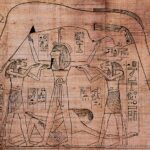
In Genesis Chronology and Egyptian King-Lists: The Egyptian Origins of Genesis History, Volume II: Egypt’s Mythological Chronology (hereinafter GKL2), I move from Volume I’s examination of Egypt’s dynastic history and its corresponding chronology in Genesis to Egypt’s mythological chronology and its correspondences in Genesis. But there is a major problem that has to be solved before that can be done. What was Egypt’s mythological chronology?
We have only two known versions of Egypt’s mythological chronology. The oldest is the Turin Canon of Kings, dating to about the thirteenth century BCE. The other, dating to about the third century, appeared in Manetho’s history of Egypt. The Turin list is in shreds and patches, and the original mythological chronology took up two and a half of the first three columns (according to Ryholt.) Most of the names and many of the lengths of reign are damaged or missing. The original Manetho source is lost to history and exists only in wildly inconsistent, heavily redacted, arithmetically erroneous versions preserved by several Christian sources.
Both lists, so far, have been impossible to reconstruct. But we can see that the mythological era in both sources ends at the start of Egypt’s First Dynasty, and both begin the chronology with the same group of six gods, the male members of Egypt’s Memphis-Heliopolis Ennead, the sequence being Ptah, Atum, Shu, Geb, Osiris, and Set. Outside of these observations, little else has been established with much certainty.
From this, I had to not only determine what the original Manetho chronology consisted of but I also needed to reconstruct the badly damaged Turin Canon. An important question to be resolved was whether the Turin Canon and Manetho, written a thousand years apart, were both based on the same chronology or each represented different chronologies. And, of course, I needed to determine what role, if any, these sources may have had on the writing of Genesis.
The first half of GKL2 is taken up with these issue, reconstructing the Turin Canon and Manetho chronologies and comparing them to chronological and genealogical data in Genesis. The journey takes me through Egyptian creation myths and the several calendars used by the Egyptians. I’m not going to go into detail here. The subject is complex and you’ll have to read the book to find out how I put everything together.
The conclusion, however, is that Manetho and the Turin Canon were based on the identical chronological structure and that the chronology was thematically based upon the (Egyptian) Theban doctrine of creation. Further, the initial Genesis scribe relied on the very same chronology to structure the primeval history in Genesis, which was later substantially redacted in the Second Temple era to harmonize with Babylonian traditions.
In the course of resolving these issues, I subsequently show how this chronology and its themes affected the stories of the seven days of creation (originally eight days of creation aligning with the mythological chronology,) Adam and Eve in the Garden of Eden (and their relationship to the Egyptian deities Geb and Nut,) the conflict between Cain and Abel (and the conflict between Set and Horus,) Noah and the Flood (the original Genesis creation story that occurred on the first day of creation,) and the descendants of Noah and the rise of nations (which lists were originally based on the Egyptian chronological lists of god-kings.)
